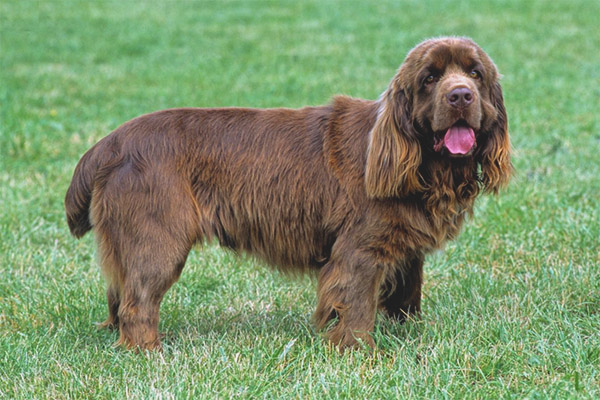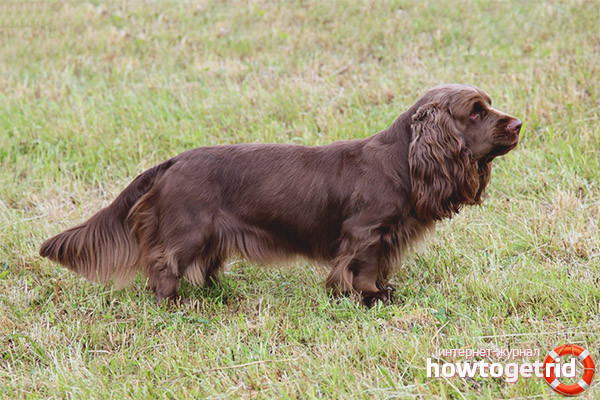The content of the article
Sussex Spaniel is a medium sized dog, distinguished by considerable strength. However, among the breed of spaniels, Sussex is considered to be the largest and most impressive. He has a large head, a wide and massive skull.
The Sussex Spaniel has expressive and large eyes, pigmented with a pleasant brown tint. Many people can see in them sadness and longing. This effect may be due to the fact that the lower eyelids are slightly drooping. The spaniel has large and hanging down ears that are covered with a thick coat of wool, which by standards should not be unduly wavy. In general, Sussex Spaniel has a beautiful, long and partly wavy coat. She needs to be a bright brown-red shade.
The tail of the dogs of this breed is not long, the limbs are strong and strong, the bones are large.Hind feet slightly longer than the front. Between the fingers there is a thick coat of wool.
In Sussex spaniels, abundant thick wool, completely smooth or partly wavy, with no tendency to curl and curl, limbs and tail as well covered with hair. The color is chestnut-golden, the hair becomes bright golden by the end, therefore, in general, golden color is predominant.
History of
The breed was named after the English county of Sussex, where nurseries were first established, in which representatives of the breed were bred. The first dog of the Sussex Spaniel breed lived in M. Fuller, who managed to fix the golden-chestnut color of these dogs.
At present, the breed is considered rare, and it was possible to survive only due to the efforts of the English resident D. Freer. Along with many other breeds, the spaniel almost disappeared completely from the face of the earth during the Second World War. And it was Freer who was able to keep eight representatives of the breed alive, which gave a new impetus to the long-term work on the restoration of the Sussex Spaniels.And in 1885, they approved the breed standard, and from that moment the Sussex spaniels were assigned to a separate group.
Breed description
Sussex Spaniel is a short-growing dog, hardly reaching 40 cm with a weight (on average) up to 22 kg. The breed standard is as follows:
- The head of the spaniel is wide, eyebrows are clearly expressed, formed, which adds some viciousness to the dog. The skull is not flat, wide.
- Muzzle of medium length - up to 8 cm, in profile has a square shape, wide. The tip of the nose is pigmented with brown, nostrils developed and wide.
- Lips slightly saggy, jaw massive, bite in the form of scissors.
- The eyes are not large, pigmented with a pleasant brown color. Dogs stand out against the background of the presence of a blinking membrane, which adds a certain warmth and softness to the dog's eyes.
- The ears are large, like blades, hanging down.
- The neck is powerful, muscular, slightly curved.
- The body of Sussex Spaniel is grounded, partly rectangular in shape, longer in relation to the height of the dog. Differs developed muscles.
- The front legs are strong, short, located immediately below the body, shoulders slightly inclined.
- The hind legs are massive, muscular, parallel to each other.
- Tail no longer than 15 cm, docked. In the process of movement, Sussex vigorously can twist without placing it above the back.
Color
The Sussex Spaniel's wool glitters, looks superbly, can be smooth or partly wavy. Representatives of this breed are not taken to cut, excluding, however, the paw pads and metatarsus. Any white spot on the body is a strong flaw in the standard.
Character traits
If the pet lives in an apartment or at home, it will be a calm, consistently obedient and balanced dog, which will be distinguished by a special attachment to its own owner. However, the spaniel will behave courteously and affably, and with the other inhabitants of the apartment.
Due to the fact that this dog is not just calm, but to some extent phlegmatic, with a benevolent nature, patience with each family member, it is often found in such families where other pets and small children live.The little ones treat adolescent sussexes, and he responds in the same way.
To a stranger, the dog will begin to show a certain suspicion and wariness, while not showing open aggression or anger. A number of Sussex Spaniel owners point out one feature of their pets, marking it as not the best — if a member of the breed feels seriously in danger or hears an unfamiliar noise, he is taken loudly, tirelessly and continuously to give voice. This may result in some inconvenience for neighbors.
With other breeds of dogs and other pets, the spaniel can perfectly coexist on the same territory, while it does not have any problems with the struggle for its own place. The only exception to the rule is birds, because the hunting instinct of Sussex Spaniel can work on them, and even high-quality socialization will not help to get rid of this predisposition.
In general, the dog has a cheerful and good-natured disposition, he is distinguished by his amazing devotion to his family, is gentle and obedient, calmly perceives the process of training, which does not prevent him from sometimes showing stubbornness.Activity, tranquility, tremendous energy in the process of hunting or walking, gentleness to other pets and an excellent attitude towards children turn Sussex Spaniel into a universal object of adoration.
The process of education and training
Representatives of this breed calmly perceived training and training, therefore it is important only to be patient and to treat the pet with care. In order to raise an energetic and healthy dog, it will be necessary not only to provide him with a balanced feed, but also to provide an opportunity to exercise. You will need to arrange long, active workouts, games and outdoor activities. Then it will turn into a benefit for Sussex Spaniel, allowing him to get not only excellent physical condition, but also emotional stability, without turning the usual phlegmatic into a real neurotic.
If possible, it is advisable to walk with your pet without using a leash or a muzzle, in places where it is allowed. It is best to give him the opportunity to engage with professional dog handlers on the run, in training where your pet will definitely show all its abilities.
It is only important to remember in the process of training that the pet will remember the commands, and then execute them with some reluctance and slowness. But this is not a consequence of low ingenuity or lack of perseverance, it is only a matter of the natural phlegm of the Sussex spaniel. Therefore, the owner of the dog will need to be patient and praise his pet with a pleasant treat after any command that has been executed correctly.
How to care for a pet
Caring for the representative of this breed is very simple, the procedure does not require serious effort from the owner.
- Initially, it is important to periodically comb the pet's coat once or twice a week.
- You will also need to regularly monitor the condition of the ears, as there can appear mats, and cut the hair between the toes.
- Fully bathe the pet should be about 3-4 times a year, or if such a need arose.
- It is important to pay attention to the ears in terms of cleanliness - if dirt and sulfur particles accumulate inside, the ears should be cleaned with a regular cotton pad moistened with clean water or a special solution.If an unpleasant characteristic odor appears, you will need to consult a veterinary doctor.
- It is necessary to cut the claws if they grow excessively. It is not recommended to use scissors, for these purposes there is a nail clipper. However, it often happens that adults can grind their claws themselves, but the puppy will definitely need to do this in the owner.
- Periodically, it is important to examine the eyes of your pet. If contamination is noted, soak a cotton pad in a tea brew or chamomile broth, and then gently process.
- Despite the fact that Sussex has strong and beautiful teeth, they also do not interfere with care. Removing plaque from the teeth or tartar is easy if you offer a dog special treats, dry granulated food or large bones.
Of course, it will take time to pass all the necessary vaccinations, regular visits to medical examinations. All this will preserve the physical shape and health of Sussex Spaniel.
Sussex Spaniel Disease
Representatives of this breed have excellent and excellent health, inherent in their nature: they live on average up to 14 years.Veterinarians call their eyes and mouth the only weak point, so it will be necessary to ensure proper care and control of these areas, periodically inspect and clean, keeping in mind that dogs are susceptible to infections.
Also, these dogs are often marked and hip dysplasia, which is congenital, which will require the owner to periodically examine the pet, offer him only high-quality balanced food and provide the necessary vitamins and minerals.
In addition, the list of the most common diseases of the Sussex Spaniel is osteochondrosis and auricle infections.
Any disease can be avoided if you follow the rule to bring the pet to the veterinarian in a stable and timely manner, as well as be able to properly inspect the Sussex Spaniel - then any disease will be determined in advance, and the course of therapy will keep your pet's health.
Feed
An adult dog is usually fed twice a day - in the morning and evening, and for a puppy it will be necessary to provide food 5 to 6 times a day, while always offering the pet clean drinking water around the clock.The owner can choose between dry and natural food. If you choose ready-made food, you will need to opt for high-quality diets for small energetic dogs.
The natural type of feeding suggests the presence of grain crops and meat, a small amount of vegetables. At the same time, it is important to take into account the activity of dogs when calculating the volumes of portions. The diet can be diluted with offal - from a boiled heart or liver, ending with a scar or welded lungs. But it is important not to dwell only on meat, you will need to enter cottage cheese or other dairy products into the diet. Sometimes you can pamper a dog with fish.













To send